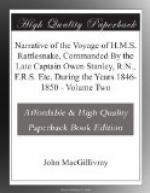On the other hand, the Redscar Bay word for throat, kato, coincides with the Australian karta of the Gudang of Cape York. Again, a complication is introduced by the word buni-mata = eyebrow. Here mata = eye, and, consequently, buni = brow. This root re-appears in the Erroob; but there it means the eyeball, as shown by the following words from Jukes’ Vocabulary:
Eye : irkeep
Eyebrow : irkeep-moos = eye-hair.
Eyeball : poni.
Eyelid : poni-pow = eyeball-hair.
Probably the truer meaning of the Redscar Bay word is eyeball.
No inference is safer than that which brings the population of the Louisiade Archipelago, so far, at least, as it is represented by the Vocabularies of Brierly Island and Duchateau Island, from the eastern coast of New Guinea. What points beyond were peopled from Louisiade is another question.
For the islands between New Ireland and New Caledonia our data are lamentably scanty; the list consisting of:
1. A short vocabulary from the Solomon Isles. 2. Short ones from Mallicollo. 3. The same from Tanna. 4. Shorter ones still from Erromanga and 5. Annatom. 6. Cook’s New Caledonian Vocabulary. 7. La Billardiere’s ditto.
The collation of these with the Louisiade has led me to a fact which I little expected. As far as the very scanty data go, they supply the closest resemblance to the Louisiade dialects, from the two New Caledonian vocabularies. Now New Caledonia was noticed in the Appendix to the Voyage of the Fly (volume 2 page 318) as apparently having closer philological affinities with Van Diemen’s Land, than that country had with Australia; an apparent fact which induced me to write as follows: “A proposition concerning the Tasmanian language exhibits an impression, rather than a deliberate opinion. Should it, however, be confirmed by future researches, it will at once explain the points of physical contrast between the Tasmanian tribes and those of Australia that have so often been insisted on. It is this—that the affinities of language between the Tasmanian and the New Caledonian are stronger than those between the Australian and Tasmanian. This indicates that the stream of population for Van Diemen’s Land ran ROUND Australia, rather than across it.” Be this as it may, the remark, with our present scanty matcrials, is, at best, but a suggestion—a suggestion, however, which would account for the physical appearance of the Tasmanian being more New Caledonian than Australian.
The chief point of resemblance between the Louisiade and the New Caledonian is taken from the numerals. In each system there is a prefix, and in each that prefix begins with a labial letter—indeed the wa of New Caledonia and the pahi of Louisiade seem to be the same roots.
1.
Brierly Island : paihe-tia.
Cook’s New Caledonia : wa-geeaing.
La Billardiere’s New Caledonia : oua-nait.
2.
Brierly Island : pahi-wo.
Cook’s New Caledonia : wa-roo.
La Billardiere’s New Caledonia : oua-dou.




